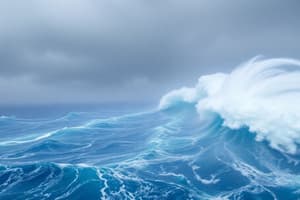Podcast
Questions and Answers
What is NOT included in an emergency kit?
What is NOT included in an emergency kit?
- Food
- Flashlights
- Clothing (correct)
- Water
Signal No. 3 indicates that strong winds may be expected in most areas of a region.
Signal No. 3 indicates that strong winds may be expected in most areas of a region.
True (A)
What should you avoid during a typhoon?
What should you avoid during a typhoon?
Flooded areas
The ______ Rainfall Warning indicates heavy to intense rainfall, which may cause severe flooding and landslides.
The ______ Rainfall Warning indicates heavy to intense rainfall, which may cause severe flooding and landslides.
Match the Storm Warning Signals with their descriptions:
Match the Storm Warning Signals with their descriptions:
What is classified as a tropical cyclone with sustained winds of 118 km/h or higher?
What is classified as a tropical cyclone with sustained winds of 118 km/h or higher?
Typhoons can only form over cold ocean waters.
Typhoons can only form over cold ocean waters.
What is the calm center of a typhoon called?
What is the calm center of a typhoon called?
A typhoon becomes more defined as it intensifies, particularly in its ______.
A typhoon becomes more defined as it intensifies, particularly in its ______.
Match the parts of a typhoon to their descriptions:
Match the parts of a typhoon to their descriptions:
Which of the following is NOT a primary hazard associated with typhoons?
Which of the following is NOT a primary hazard associated with typhoons?
The Philippines experience typhoons due to its location in the typhoon belt.
The Philippines experience typhoons due to its location in the typhoon belt.
What role does warm ocean water play in the formation of a typhoon?
What role does warm ocean water play in the formation of a typhoon?
Flashcards
Emergency Kit Components
Emergency Kit Components
Essential supplies like water, food, medications, flashlights, and a battery-powered radio needed during emergencies
Evacuation Plan
Evacuation Plan
Identify safe routes and shelters to be used during an emergency, such as a typhoon.
Storm Signal 3
Storm Signal 3
Strong winds expected in most areas of a region.
Red Rainfall Warning
Red Rainfall Warning
Signup and view all the flashcards
Safety During Typhoon
Safety During Typhoon
Signup and view all the flashcards
Typhoon
Typhoon
Signup and view all the flashcards
Tropical Cyclone Intensity
Tropical Cyclone Intensity
Signup and view all the flashcards
Typhoon Eye
Typhoon Eye
Signup and view all the flashcards
Typhoon Eyewall
Typhoon Eyewall
Signup and view all the flashcards
Typhoon Formation Energy Source
Typhoon Formation Energy Source
Signup and view all the flashcards
Typhoon Hazards
Typhoon Hazards
Signup and view all the flashcards
Typhoon Formation: Coriolis Effect
Typhoon Formation: Coriolis Effect
Signup and view all the flashcards
Philippine Typhoon Risk
Philippine Typhoon Risk
Signup and view all the flashcards
Study Notes
Typhoons
- A typhoon is a large rotating storm system with a low-pressure center, strong winds, and heavy rainfall.
- It's a type of tropical cyclone forming over warm ocean waters.
Types of Tropical Cyclones
- Classified by intensity:
- Tropical Depression: Maximum sustained winds up to 61 km/h (38 mph).
- Tropical Storm: Maximum sustained winds 62-88 km/h (39-54 mph).
- Typhoon: Maximum sustained winds 118 km/h (73 mph) or higher.
- Super Typhoon: Extremely powerful with maximum sustained winds of 241 km/h (150 mph) or higher.
Parts of a Typhoon
- Eye: The calm center of the storm.
- Eyewall: A ring of intense thunderstorms surrounding the eye.
- Spiral Bands: Bands of thunderstorms spiraling outward from the eyewall.
How Typhoons Form
- Warm Ocean Waters: Warm ocean waters provide energy for typhoon formation.
- Low-Pressure Area: A low-pressure area develops over warm ocean waters.
- Rising Air: Warm, moist air rises creating low pressure.
- Condensation and Cloud Formation: Rising air cools, condenses, and forms clouds.
- Rotating Winds: The Coriolis effect causes rising air to rotate, creating a spinning storm.
- Intensification: As the storm intensifies, winds strengthen and the eye becomes defined.
The Philippines and Typhoons
- The Philippines is highly prone to typhoons due to its location within the typhoon belt.
- Warm ocean currents and atmospheric conditions favor typhoon formation in this region.
Typhoon Hazards
- Strong Winds: High-speed winds damage buildings, uproot trees, and cause power outages.
- Heavy Rainfall: Intense rainfall causes flooding, landslides, and mudslides.
- Storm Surge: Strong winds and low atmospheric pressure cause a rise in sea level, flooding coastal areas.
- Tornadoes: Tornadoes can form within the outer bands of a typhoon.
Typhoon Preparedness and Response
- Create an Emergency Kit: Assemble essential supplies.
- Develop an Evacuation Plan: Identify safe routes and shelters.
- Stay Informed: Monitor weather forecasts and warnings.
- Follow Safety Guidelines: Stay in during a typhoon, avoid flooded areas, and watch for falling debris.
- Participate in Community Preparedness Activities: Join community drills.
Storm Warning Signals
- PAGASA (Philippine Atmospheric, Geophysical and Astronomical Services Administration) issues storm warning signals to alert the public.
- Signal No. 1: Strong winds expected in coastal areas.
- Signal No. 2: Stronger winds expected in coastal areas.
- Signal No. 3: Strong winds expected in most areas of a region.
- Signal No. 4: Very strong winds expected in most areas of a region.
- Signal No. 5: Violent winds expected in most areas of a region.
Rain Warning Signals
- PAGASA issues rain warning signals to alert the public.
- Yellow Rainfall Warning: Light to moderate rain, flooding possible in low-lying areas.
- Orange Rainfall Warning: Moderate to heavy rain, flooding and landslides possible.
- Red Rainfall Warning: Heavy to intense rainfall, severe flooding and landslides possible.
Studying That Suits You
Use AI to generate personalized quizzes and flashcards to suit your learning preferences.




